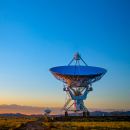
The Challenge of Crystal Eye to Gamma Ray Bursts
Last year, we discussed one of Astra's key components: the development of Crystal Eye, a crucial instrument within Astra's Work Package 1, the one dedicated to advancing new hardware technologies.
The work on the experiment has continued over the past few months. Naturally, the development of such a prototype involves a complex journey. Crystal Eye relies on innovative technology that incorporates new materials and sensors. "We are creating a compact and highly sensitive scientific instrument designed to operate in orbit, constantly monitoring the entire sky to detect gamma ray bursts," says Ivan De Mitri (picture), Professor of Experimental Physics at the Gran Sasso Science Institute (GSSI) and Work Package 1 Leader within the Astra project.
Gamma ray bursts are events that occur at enormous distances from the observer. Deep understanding of them remains an ambitious goal for science, as it is still among the most mysterious and powerful phenomena in the universe.
The key feature of the prototype lies in the use of scintillating crystals, which emit a flash of light each time they are hit by ionizing radiation, such as that produced by gamma bursts. "These crystals, when impacted by high-energy radiation, produce flashes of light that are captured by silicon photomultipliers, compact and efficient devices", adds the professor from GSSI. This approach allows for reducing the size of the device without compromising its detection capability.
Gamma-ray bursts were discovered by chance during the Cold War by small satellites launched into orbit by the US Air Force, whose purpose was to detect possible nuclear tests by observing bursts of X-rays and gamma rays. After several years of data collection, scientific analysis revealed the existence of gamma-ray flashes lasting only a few seconds, with both Earth and the Sun ruled out as their origin. These results were published in 1973, and the phenomena were named Gamma Ray Bursts (GRBs). “Today we know that gamma-ray bursts are caused by events such as the death of massive stars or the merger of binary systems of neutron stars, which occur in distant galaxies and release enormous amounts of energy", says De Mitri.
The device is designed to capture these light signals with an accuracy of about one degree. Once detected, the system can immediately send an alert to the scientific community, indicating the precise location of these radiation events in the sky. “The speed at which we can localize such an event is crucial to allow other instruments to study it in a complementary way, and to improve its localization in the sky in order to identify the source", says the researcher, referring to the ability to leverage the project within a multimessenger approach, which we have discussed in the past.
The ability to detect gamma ray bursts in real time has applications not only in astrophysics but also in other fields of science. For example, the crystals used could also be employed to monitor terrestrial atmospheric phenomena, such as Terrestrial Gamma-ray Flashes (TGFs), which occur during very powerful storms. “Although these events do not originate in space, they are similar to cosmic gamma bursts and provide us with important data on atmospheric physics,” explains De Mitri.
A Crystal Eye prototype will be tested aboard the European Space Agency's (ESA) Space Rider mission: "For us, Space Rider represents a crucial phase of the project, as it will allow us to verify the functioning of the devices and gather data on their behavior during flight," says De Mitri. The launch is expected for the end of 2026, with the payload returning to Earth for post-mission analysis.
With Crystal Eye, we are poised to open a new frontier in observing the most extreme events in the cosmos. This is made possible through international collaborations, demonstrating how research can be applied in interdisciplinary contexts, combining astrophysical expertise, advanced technologies, and a clear focus on the future of space exploration.

